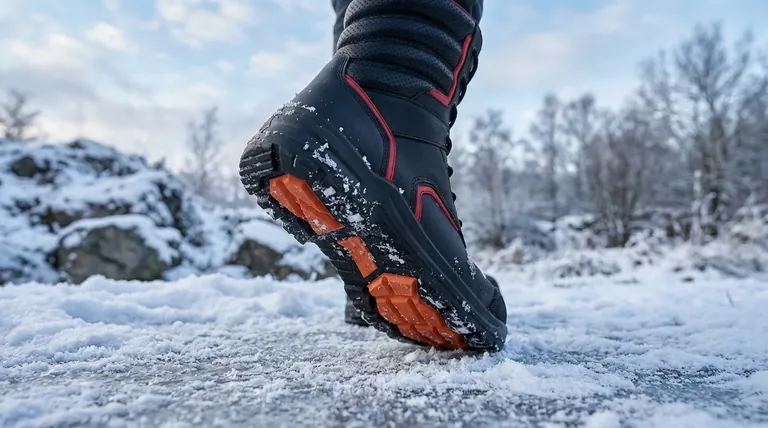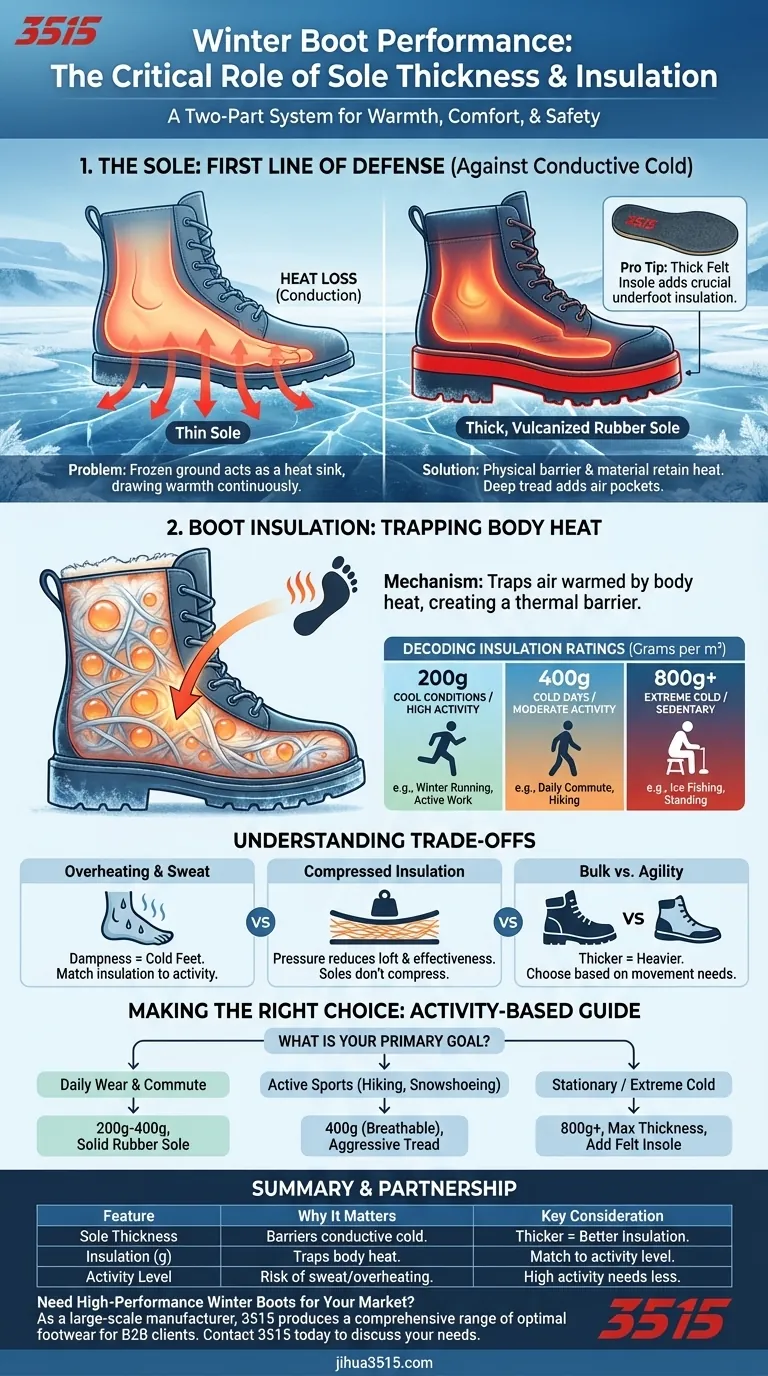Critically important. For winter boots, sole thickness and insulation are the two primary features that determine whether your feet stay warm, comfortable, and safe. Insulation protects your feet from the cold air, but the sole is what insulates you from the frozen ground, a massive surface that constantly pulls heat away from your body.
The warmth of a winter boot is a two-part system. Insulation traps the heat your body produces, while a thick, well-made sole acts as a crucial barrier against persistent, conductive cold seeping up from the ground. Neglecting either one will compromise the boot's effectiveness.

Why the Sole is Your First Line of Defense
The ground in winter is a relentless heat sink. Understanding how your boot's sole counteracts this is essential for choosing the right footwear.
The Problem: Conductive Heat Loss
Your body loses heat to any colder surface it touches through a process called conduction. When you stand on frozen ground, it actively and continuously draws warmth out of your feet, far more effectively than cold air does.
A thin sole offers little resistance to this process, allowing your feet to become cold regardless of how much insulation is packed into the rest of the boot.
The Solution: Thickness and Material
A thick sole creates physical distance between your foot and the cold ground, which is the simplest and most effective form of insulation against conduction.
Materials like vulcanized rubber (used in brands like Vibram) are standard for quality winter boots because they retain heat well and are highly durable in harsh conditions. Deep tread also adds to the sole's effective thickness, creating pockets of air that offer further insulation.
The Impact of Insoles
You can significantly boost underfoot warmth by adding a separate insole. A thick felt insole, for example, can add a substantial layer of insulation precisely where it's needed most to fight conductive heat loss.
Decoding Boot Insulation
While the sole protects from below, the boot's primary insulation protects your foot from the surrounding cold air.
How Insulation Works
Insulation in boots consists of a thick layer of fabric or material, either synthetic or natural (like shearling), that is designed to trap air. This trapped air is warmed by your body heat, creating a thermal barrier that slows down heat escape.
Understanding Insulation Ratings
Many manufacturers rate their boot insulation in grams. This number refers to the weight of the insulation material in a square meter, which corresponds to its thickness and warmth.
- 200g: Best for cool conditions or high-activity levels where you generate a lot of your own heat.
- 400g: A common all-around choice for cold winter days and moderate activity.
- 800g+: Designed for extremely cold temperatures or sedentary activities like ice fishing or standing for long periods.
Understanding the Trade-offs
Choosing the right boot isn't about maximizing every feature. It's about finding the right balance for your specific needs.
Overheating and Sweat
Excessive insulation for your activity level is a serious problem. If your feet get too hot, they will sweat. Damp socks and a wet boot interior will then make your feet feel intensely cold as soon as you stop moving.
Compressed Insulation Loses Value
The insulating power of materials, including socks, comes from their loft, or the air they trap. The pressure of standing and walking compresses this loft, reducing its effectiveness. This is another reason why a thick, non-compressible rubber sole is so critical.
Bulk vs. Agility
Thicker soles and heavier insulation add weight and bulk to a boot. For high-energy activities like winter running or fast-paced hiking, this can be a significant drawback, making a lighter, less insulated boot a better choice.
Making the Right Choice for Your Goal
Select your boot's features based on your intended use, not just the temperature on a thermometer.
- If your primary focus is daily wear and commuting in a cold city: A boot with 200g-400g of insulation and a solid, non-slip rubber sole is ideal.
- If your primary focus is active winter sports like hiking or snowshoeing: Prioritize a balance of 400g insulation with a breathable design to manage sweat, paired with a thick sole and aggressive tread for traction.
- If your primary focus is stationary activity in extreme cold (e.g., ice fishing, outdoor work): Maximize both features with 800g or more of insulation, the thickest sole you can find, and consider adding a supplemental felt insole.
By matching your boot's sole and insulation to your specific climate and activity, you take direct control over your comfort and safety in the cold.
Summary Table:
| Feature | Why It Matters | Key Consideration |
|---|---|---|
| Sole Thickness | Creates a barrier against conductive heat loss from frozen ground. | Thicker soles provide better insulation. Vulcanized rubber is ideal. |
| Insulation (grams) | Traps body heat to protect against cold air. | 200g for activity, 400g for general use, 800g+ for extreme cold/stationary use. |
| Activity Level | Determines the risk of sweat and overheating. | High activity needs less insulation; low activity needs more. |
Need winter boots that perfectly balance warmth, durability, and performance?
As a large-scale manufacturer, 3515 produces a comprehensive range of footwear for distributors, brand owners, and bulk clients. Our production capabilities encompass all types of shoes and boots, including high-performance winter boots engineered with optimal sole thickness and advanced insulation for any condition.
Contact 3515 today to discuss your winter boot needs and get a quote. We'll help you deliver the comfort and safety your customers demand.
Visual Guide

Related Products
- Premium Wholesale Waterproof Safety Boots High Performance Protection for Industrial Markets
- Wholesale Safety Footwear Manufacturer for Bulk & Custom OEM Orders
- Customizable Anti-Smash Safety Boots for Wholesale & Private Label Manufacturing
- Custom Wholesale Leather Safety Boots Direct Factory Manufacturing
- Premium Grain Leather Safety Boots for Bulk Supply
People Also Ask
- What boots do they wear on oil rigs? Essential Safety Footwear for Harsh Conditions
- What is the OSHA standard for safety-toe boots? Ensuring Compliance and Worker Protection
- Is there a downside to steel toe boots? Weighing Protection Against Daily Comfort
- What is the primary purpose of safety shoes? Your Ultimate Guide to Workplace Foot Protection
- What are the key considerations when choosing safety boots? Match Hazards to Features for Maximum Protection



















